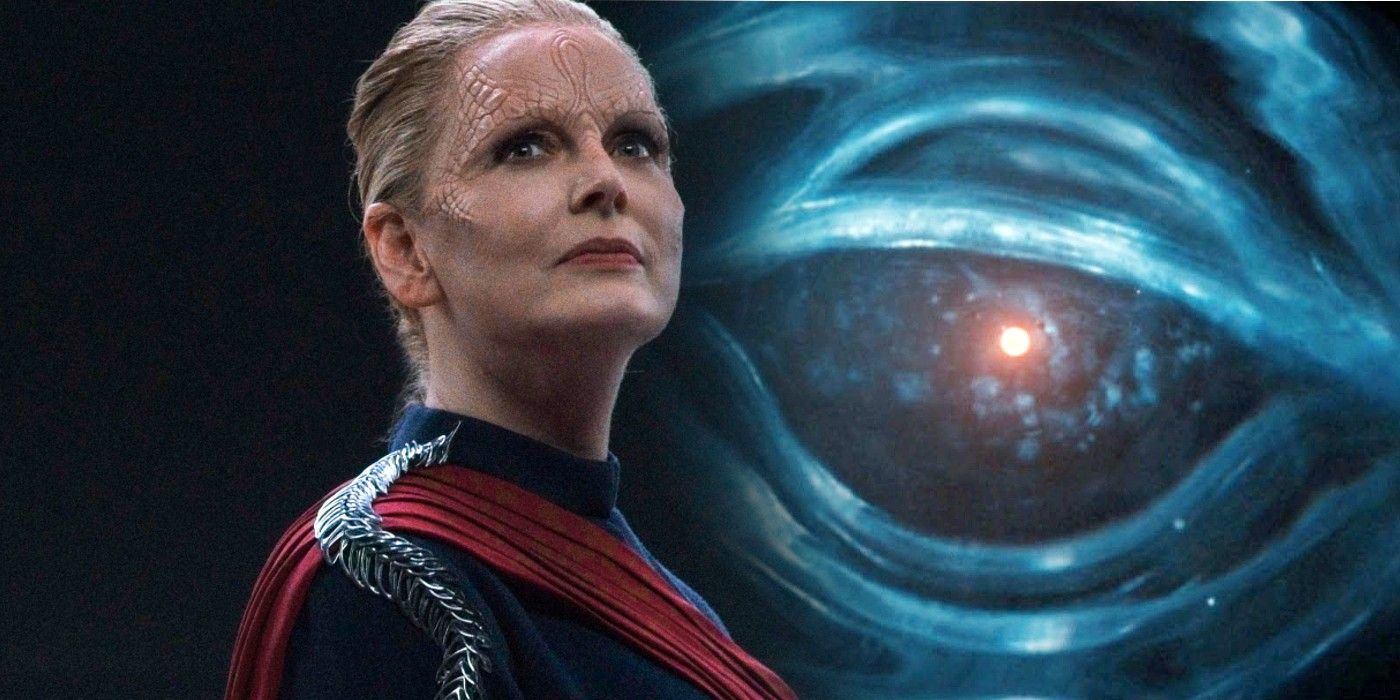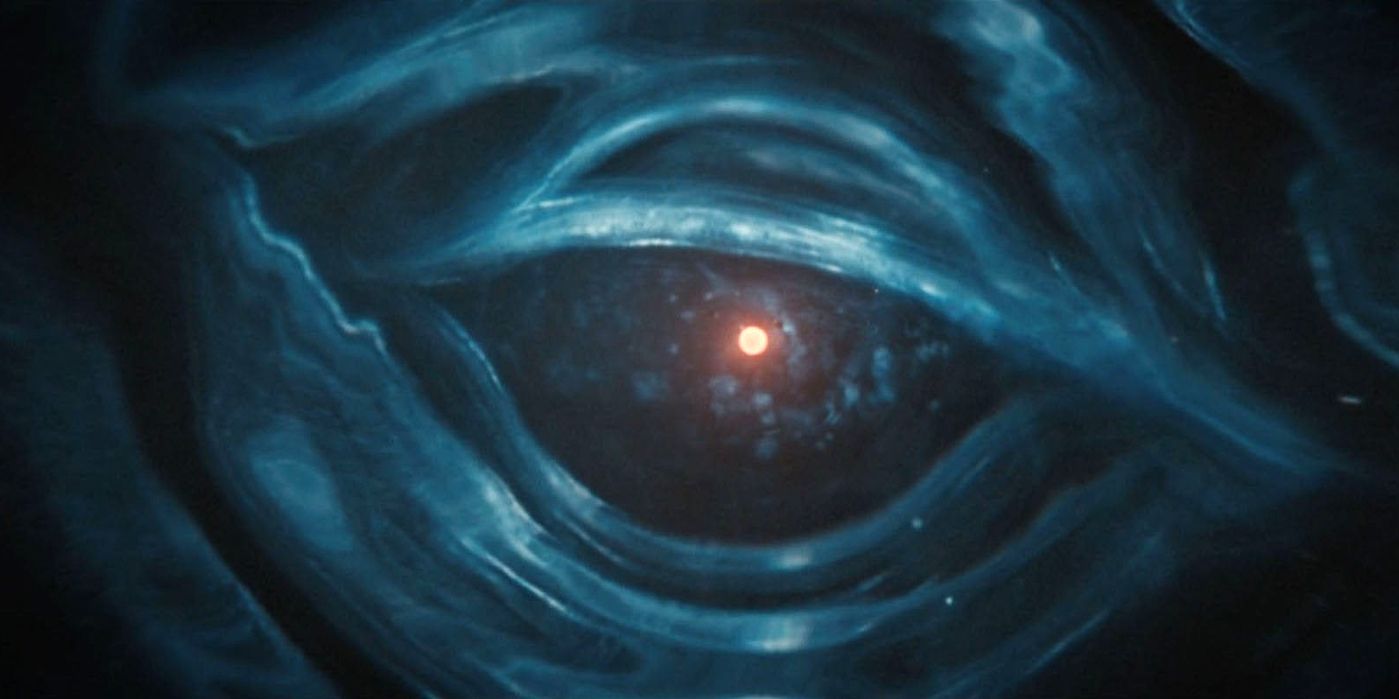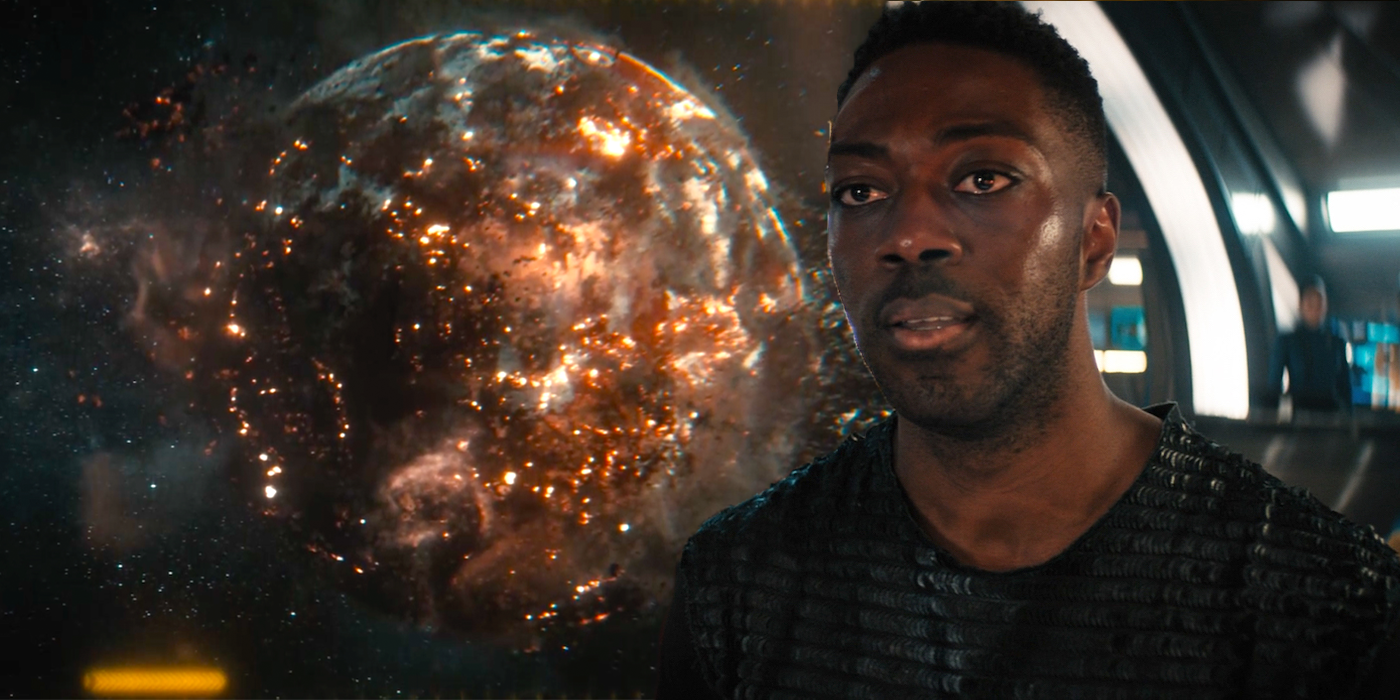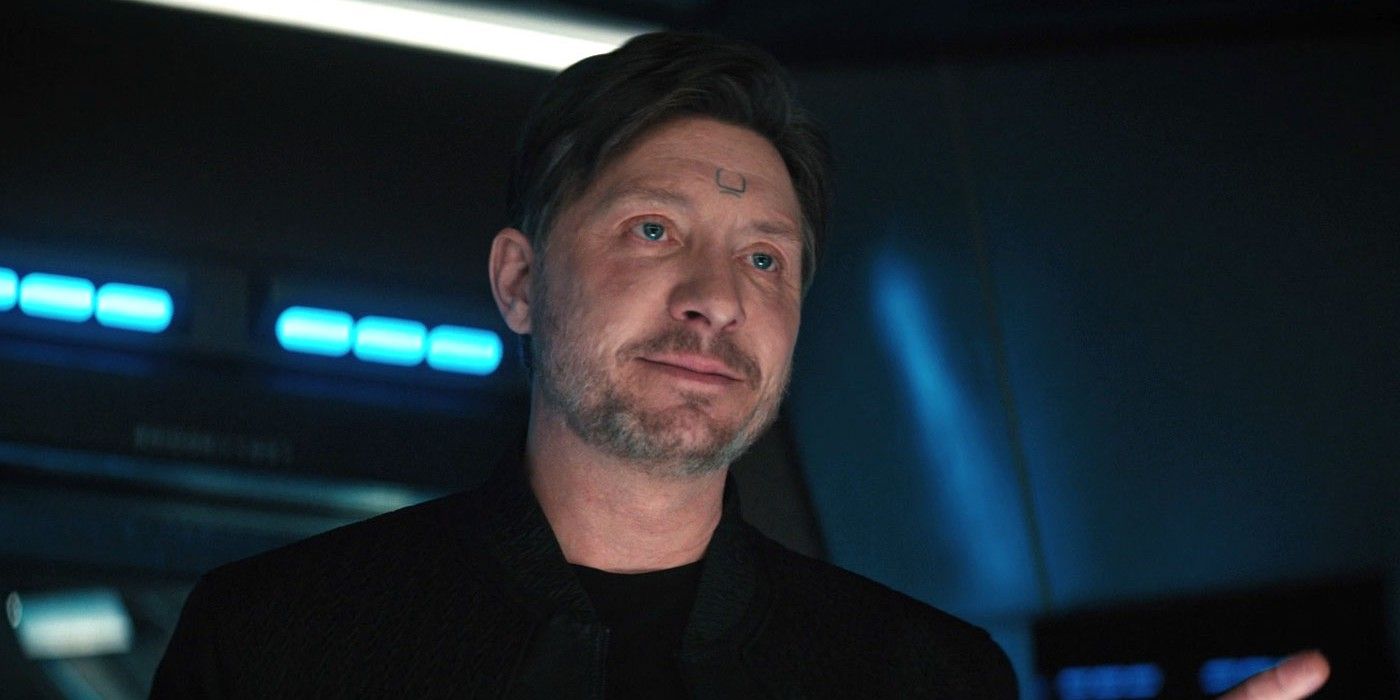The mysterious DMA threatens Star Trek: Discovery's entire galaxy, but is the "Unknown Species 10-C" that caused it actually the Federation turned evil? Star Trek's 32nd century has an uncanny knack for natural disasters that ultimately prove to be distinctly unnatural. After the Burn in season 3, Star Trek: Discovery season 4 introduced a new threat - the Dark Matter Anomaly. Known by its slightly more snappy title of the "DMA," this new cataclysm is an unpredictable gravitational wave capable of destroying entire planets and then jumping through space to its next target. Needless to say, Michael Burnham has her work cut out in her debut captaincy season.
Since the DMA first appeared, Lieutenant Commander Paul Stamets has been leading the charge to determine its cause. Though the all-important questions remain unanswered, Stamets has deduced that a device sits at the heart of the anomaly, which in turn means the DMA must be made by an intelligent life form. Discovery has dubbed these elusive aggressors "Unknown Species 10-C" but is no closer to identifying who the 10-C are, or where they come from.
Star Trek: Discovery season 4 lulls viewers into assuming Unknown Species 10-C must be a brand new addition to the franchise, conjuring memories of Star Trek: Voyager's Species 8472. Instead, the danger may sit closer to home. Could Unknown Species 10-C - and, therefore, those responsible for the DMA - be President Laira Rillak and the United Federation of Planets?
Star Trek: Discovery's Federation Is Benefiting From The DMA
Thanks to the Burn (combined with the Federation's own unabashed ineptitude), the coalition is a shadow of its former glory in Star Trek: Discovery's 32nd century. But after Michael Burnham helped solve the Burn puzzle and scored the Federation a fresh store of juicy, warp-guzzling dilithium, the Federation began to rebuild in earnest. As members new and old signed up, the Federation grew from strength to strength between Star Trek: Discovery seasons 3 and 4 - but how can that process go a little bit... quicker?
When creating an alliance, one of the oldest tricks in the book is uniting disparate sides behind a common enemy. Whomever ends up being responsible, there's no doubting the DMA is the perfect common enemy. As a seemingly natural phenomenon, the DMA can't be bought, killed, or reasoned with. The big googly space eye is pure destruction that leaves planets in its path with two choices - run or die. That situation plays directly into the Federation's hands.
Burnham's opening Captain's log entry in Star Trek: Discovery season 4, episode 4 ("All Is Possible") reveals that as a direct result of the DMA's looming threat, negotiations for Ni'Var (the union of Vulcan and Romulan cultures) to rejoin the Federation has been fast-tracked. Adding Ni'Var's star to the Federation flag represents a massive step toward rebuilding, and President Rillak has the DMA to thank for getting that deal across the line. Meanwhile, smaller Federation members have become more compliant since the anomaly emerged. According to Saru, his home planet of Kaminar is fearful of the future and, therefore, reliant on the Federation's protection and guidance. These examples provide Rillak's Federation with a clear motive for causing the DMA - scare citizens into following the one organization that purports to protect them.
Rillak's own political response to the DMA has only heightened suspicions. When the danger first became clear, she declared, "Federation, non-Federation - this anomaly threatens us all equally. We must all work together." Despite promising cooperation, however her message is crystal clear - without the Fed, you're doomed. She reaffirms this stance to Michael Burnham during a delicate joint-mission with Ni'Var's Qowat Milat, reminding Discovery's captain, "This is our moment to serve and to show why restoring the Federation is so critical." At the very least, Rillak and the Federation are taking full advantage of the DMA situation - who's to say they aren't Unknown Species 10-C?
Why The Federation Would Destroy Booker's Kwejian
Thus far in Star Trek: Discovery season 4, two major locations have been decimated by the DMA - Cleveland Booker's home planet of Kwejian, and the Radvek asteroid belt colony. Curiously, both are places the Federation might've wanted to quietly get rid of.
Star Trek: Discovery season 4's premiere revealed the Federation have been busily attempting to replicate Discovery's spore drive for widespread use across Starfleet. According to Stamets, they've virtually cracked the technology, but have one final hurdle to overcome before the prototype can be considered usable - a pilot. Discovery's spore drive requires a human interface to navigate the mycelial network, and only Paul Stamets - the man who pioneered the system - is capable of serving as the spore drive's controller... or at least he was until Cleveland Booker came along. Booker hails from the planet Kwejian, where some inhabitants are born as empaths who can psychically commune with nature. As the mycelial network is, essentially, nature, Booker possesses an intuitive ability to pilot Discovery's spore drive.
If the Federation is close to reproducing spore drive technology and has concocted an alternative to having a living pilot interface like Stamets or Booker (which Rillak hints in Star Trek: Discovery season 4, episode 1), destroying Kwejian would make strategic sense. The Federation will desperately want to avoid spore drive technology falling into enemy hands, and Kwejian represents a planet full of potential empath pilots like Booker, who non-Federation entities could use to power their own spore systems. With Kwejian out of the picture, the Federation holds a monopoly on spore technology, and the DMA could've been deployed there for that very reason.
The other major DMA victim in Star Trek: Discovery season 4 is the Radvek asteroid colony which, conveniently for the Federation, is a former territory of the villainous Emerald Chain - the post-Burn enemies of season 3. Though Burnham's crew defeated the Emerald Chain and killed its leader, Osyraa, Radvek's inhabitants still follow the old ways. The colony's magistrate is heard citing the Emerald Chain tradition of leaving behind convicted "examples" on the dying rock to serve as warning to other would-be law-breakers. The DMA has done the Federation a solid by rampaging through this Emerald Chain colony. Even if most inhabitants were evacuated and rescued, they'll be split up and assimilated into the Federation, leaving one less Emerald Chain stronghold in the galaxy.
How Did The Federation Create The DMA In Star Trek: Discovery Season 4?
Motive and opportunity are in abundant supply, but does the Federation actually have the means to create a gravitational anomaly 5 light years wide and steer it through space? Rillak name-drops powerful species such as Metrons, Nacene and the Q Continuum among those capable of building such a weapon, and the Federation's 32nd century science pales in comparison to those God-like civilizations.
Theoretically, however, Federation scientists do have the technology and knowledge to build a DMA. In Star Trek: Discovery season 4, episode 5 ("The Examples"), Ruon Tarka puts together a miniature DMA inside Discovery as a means of learning more about the phenomenon. As the arrogant genius later explains, his only real stumbling block is generating enough power to keep the anomaly active. Gravitational clouds of destruction don't run on everyday electricity, and Tarka believes you'd require a hyper-giant star to deliver the necessary juice. Presumably, there's no such star within Federation-charted territory, otherwise Discovery would already be there investigating. But what if the power source came from elsewhere? Star Trek: Discovery season 3 revealed Kovich's science division are familiar with alternate universes caused by time travel, and though the practice is outlawed, it's feasible the Federation drew upon futuristic parallel universe technology to create and fuel the DMA. This is, of course, incredibly dangerous to the fabric of reality.
Tarka himself - potentially along with Kovich - could be the man behind it. The recklessness of Tarka's Discovery experiment proves he'll willingly sacrifice human lives in the name of scientific advancement, and when later questioned on his methods, the character ominously replies, "Science has many purposes." Perhaps the purpose of Tarka's miniature DMA simulation wasn't to figure out how it started, but to find a way to make it more efficient, deadly, or controllable. Tarka was exploiting Stamets' unquenchable thirst for knowledge to improve the DMA right under his rival's nose.
That would also explain why President Rillak insisted on accompanying Discovery for the Beta-Six rescue mission in Star Trek: Discovery season 4's premiere. She wanted to survey the DMA's successful trial run from an inconspicuous vantage point - and what could be more inconspicuous than riding along with the evacuation team? Since the gravitational anomaly appeared, Star Trek: Discovery has been all about coming together and uniting to confront a common danger, honoring Gene Roddenberry's original utopian vision for the show. That could all come crashing down if the Federation is revealed as Unknown Species 10-C, and the creators of the DMA.
Star Trek: Discovery season 4 airs every Thursday on Paramount+.




